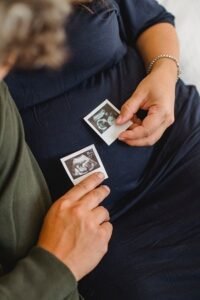I hope by sharing my natural pregnancy story I can provide support and inspiration for women who have had infertility challenges like me.
Overcoming Infertility
I’ve spent many nights reading about people’s experiences with infertility, and it gave me strength and reminded me that I’m not alone. For that I am grateful, and I hope I can do the same for others.
My story has a beginning and a middle – but no end. I’m living it everyday, and I’m writing about it. Along with millions of other women, I find myself in the midst of a struggle to conceive a child. I’ve cried, I’ve laughed, I’ve sobbed uncontrollably, I’ve miscarried, I’ve had surgery, I’ve been to mystic healers, I’ve taken herbs, and I’ve swallowed little white pills better known as Clomid.
It’s been about three years since my husband and I got on the family building rollercoaster – which we didn’t even realize we were on until after about two years of sitting in the front row.
What I came to realize is that there are so many factors that affect fertility that can – if given the chance – be addressed with natural remedies.
How do I know this? I have experienced it first hand.
Natural Pregnancy Alternate Fertility Therapies
After a few rounds of taking progesterone suppositories prescribed by my gynecologist to treat my short luteal phase, I realized that the suppositories were only treating a symptom.
Why do I have a short luteal phase?
Can what is causing it, be healed?
In essence, I wanted a holistic approach, so I turned to acupuncture. This is when I experienced first hand the power of alternative therapies.
Acupuncture and Some Not So Tasty Tea
Traditional Chinese Medicine turned my irregular menstrual cycles, with an average length of 33 days, into regular menstrual cycles with an average length of 28 days.
Impressive results, but the complete astonishment came when the pain that accompanied my menstrual cycle vanished – completely! And this pain was not your average premenstrual cramping; it was an excruciating pain which I used to counter with the pill and various painkillers.
This amazing transformation, after seven months of acupuncture and Chinese herbal tea, seemed to bring me closer to what would be considered more fertile.
But, I did not get pregnant and the effects weren’t all heading in the right direction. My acne worsened, my premenstrual spotting continued and my bleeding with each cycle dwindled down dramatically – to the point where I felt as if the acupuncture were suppressing my cycle altogether.
My husband and I realized that this getting pregnant thing may be a little more involved than we originally thought. So, to eliminate any male factors, he went in for a semen analysis.
When his values all came back normal we headed back to the female factor drawing board.
Back to Conventional Medicine and the Little White Pill
After experiencing the power of alternative medicine I was determined to find a gynecologist that offered both conventional and alternative treatments with a holistic approach, otherwise known as integrative medicine.
This search turned out to be futile. The closest I came was a gynecologist that listed acupuncture as one of her treatment methods.
Sitting across from her in her office, though, there was no talk of alternative treatment options. I walked out that day with a prescription for Clomid and progesterone.
I took the little white Clomid pill on each of my cycle days, five through nine, and then went in several times for monitoring. This involved getting my blood drawn and a few ultrasounds.
Three follicles developed and my husband and I enjoyed this time – in what we hoped would be to conceive our first child. But after obediently taking progesterone suppositories during the second half of my cycle, I was greeted with only one stripe on the pregnancy test.
Kleenex. Ice Cream. Movie Marathon. Need I say more?
Natural Pregnancy With Acupuncture: Take Two
The toggling trend between alternative and conventional medicine continued as I scoured the internet now for a new acupuncturist: one with experience treating infertility.
I found no such specialist nearby, but I did found a medical doctor who was now a certified full-time acupuncturist. On the phone, she oozed with confidence stating that she could treat my infertility having successfully treated a man with a low sperm count.
One patient does not exactly constitute infertility expertise, but it was the best I could find. So, for three and a half months I drove 45 minutes each way for my, initially, weekly and later every other week appointments.
It seemed as though my system could be heading in the right direction. My menstrual pain once again vanished and I noticed a marked improvement in my circulation (my hands and feet no longer passed as ice cubes).
But this time my cycles did not become regular, my acne flared up again and my premenstrual spotting continued. When I pointed out the persistence of these symptoms to my acupuncturist she tensed and said, “I have never had such a situation. There’s no reason you can’t get pregnant – it’s emotional.”
I was confused and taken aback by her response, but she was clearly distraught and it was utterly apparent – there was nothing else she could do.
Time for a Fertility Specialist
After two years of trying to conceive a child I was – to say the least – frustrated.
My reproductive system was struggling to align itself with what’s considered fertile and my efforts had not produced a single positive pregnancy test. So, I felt it was time. Time to turn back to conventional medicine. Time to go deeper into the evaluation process. And time to consider more in-depth testing procedures.
This may mean submitting my body to more invasive tests, but, I reasoned: what’s the point of attempting more alternative treatments if I have, for example, blocked fallopian tubes?
Our Fertility Clinic Experience
My husband and I sat in the fertility clinic like two mice. Not at all typical for us, but we sat there and heard the recommendations, nodding our heads.
I mentioned my interest in combining alternative treatments like acupuncture with conventional medicine, but without hesitation the doctor shot down alternative treatments as a waste of time.
Not giving up, I presented the results I had had with acupuncture so far. He then admitted to trying acupuncture on his patients himself and said that it had had no effect. Stating then boldly, “Of course your menstrual pain was gone but acupuncture doesn’t help infertility.”
I didn’t follow his reasoning here, but before I could ask him to elaborate he continued on with his protocol.
The Important Test
This was not the right doctor for me. That much was clear. But he did recommend one test before beginning conventional infertility treatments: a Hysterosalpingogram (HSG).
I nodded my head in complete agreement for the first time since I entered his office. This procedure would determine if there were any blockages in my fallopian tubes.
With no intentions to become his patient, I scheduled an appointment. After all I wasn’t looking for a new doctor; I only wanted to eliminate any medical conditions that couldn’t be addressed with alternative treatments.
Nervous, I lay on the table in the operating room. A fluid was injected into my uterus that, if all went well, would flow freely through my fallopian tubes.
And indeed – it did! Back to alternative medicine.
A Lesson Learnt: Stop, Look and Listen
“Before you cross the street you should stop, look and listen” – a good bit of advice for those facing infertility. I was so wrapped up in getting pregnant now, I didn’t have a plan: I just kept running toward the first thing that sounded like a solution to my problem. But it was time: Time to stop running in random directions; time to look at the facts; and time to listen to my feelings.
So, my husband and I made a fertility plan.
 This was one of the best things we did for our sanity. Facts become clearer in black on white and so many decisions crystallized on how we wanted to proceed.
This was one of the best things we did for our sanity. Facts become clearer in black on white and so many decisions crystallized on how we wanted to proceed.
In our plan we cover what our current situation is, what treatments we are willing to try, how long we are willing to try each one, what resources and fertility centers are available to us, a financial summary, and a timeline of how we want to precede.
Perhaps the most important outcome of making this plan is that we discovered how we feel. We took the time to really listen to our own thoughts and feelings and to discuss them with each other.
We spared nothing; we talked about each individual topic and treatment – no matter how uncomfortable it got.
So what was our Natural Pregnancy plan?
We decided there were several alternative treatments we wanted to try for the next several months and then, if not pregnant, to go to a clinic for conventional infertility treatment. And since the lead time to get into a clinic is long, we began that process in parallel with the alternative treatments.
Everything Alternative
Over the next four months I tried a slew of alternative treatments including: Mayan abdominal massages, castor oil packs, vitamin supplements, chiropractic treatment, a liver cleanse and a gallbladder flush.
I went for daily long walks and adjusted my diet. And yes, my spare time revolved completely around making my body more fertile.
The grand finale to this alternative therapy marathon was a two week ‘fertility vacation’ at a hotel in the foothills of the Alps where we received daily mud baths.
Upon our return home from this trip, I took my ritual pregnancy test and it was – to my utter shock and joy – positive!
Unfortunately, it turned out to be an ectopic pregnancy (which you can read about in detail in my fertility blog). Certainly a crushing outcome. It was, however, the closest we had ever come to having a child.
It was progress. We knew it was possible. We were not giving up hope.
Our Revised Natural Pregnancy Fertility Plan
Recovering from the laparoscopic surgery for my ectopic pregnancy took a long time emotionally and physically. The surgery was more involved than anticipated because the doctor discovered more than just an ectopic pregnancy. He found and removed a water cyst, a myoma, and stage one endometriosis.
These conditions certainly shed some light on why getting pregnant was proving difficult. But their removal surgically doesn’t equate to a solved problem. The doctor made this clear to my husband and me by suggesting we try again on our own but that we “don’t wait too long before returning to the infertility clinic.”
After the laparoscopic surgery we were given a three month waiting period before we were allowed to try and conceive again so that I could recover.
As it turns out, eight months after the surgery, my body has not yet returned to equilibrium: with cycle lengths of about 38 days.
Emotionally, it took me about six months to completely heal from the miscarriage.
What the surgery did do, though, is improve my quality of life. I no longer have menstrual pain. Life without this pain is wonderful. But a life without children is not yet complete. And so we revised our fertility plan and began again.
Ps: We did it, we had a son by method that we accidently found. It is naturally therapy!

